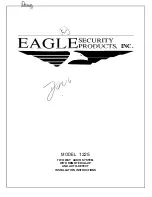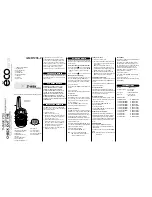
A-80 UHF
SERVICE MANUAL
- 9 -
The PLL circuit generates the first local oscillator signal for reception and the RF signal for
transmission.
1
)
PLL
The frequency step of the PLL circuit is 2.5 or 3.125 KHz. A 12.8MHz reference oscillator signal is
divided at IC100 by a fixed counter to produce the 2.5 or 3.125 KHz reference frequency. The voltage
controlled oscillator (VCO) output signal is buffer amplified by Q102, then divided in IC100 by a
dual-module programmable counter. The divided signal is compared in phase with the 2.5 or 3.125 kHz
reference signal in the phase comparator in IC100. The output signal from the phase comparator is
filtered through a low-pass filter and passed to the VCO to control the oscillator frequency.
2
)
VCO
The operating frequency is generated by Q101 in transmit mode and Q104 in receive mode. The
oscillator frequency is controlled by applying the VCO control voltage, to the varactor diodes (D102
and D103 in receive mode and D100 and D101 in transmit mode). The RX pin is set low in receive
mode, and TX pin is set low in transmit mode. The outputs from Q104 and Q101 are amplified by
Q102 and sent to the buffer amplifiers Q103.
3
)
UNLOCK DETECTOR
If a pulse signal appears at the LD pin of IC100, an unlocked condition occurs, and the DC voltage
obtained form D105, R126 and C144 causes the voltage applied to the LOCK pin of the
microprocessor to go low. When the microprocessor detects this condition, the transmitter is disabled
and the error indicating alarm occurs, ignoring the push-to-talk switch input signal
4.Transmitter
1
)
Transmit audio
The modulation signal from the microphone is amplified by IC400 (1/2), passes through a
pre-emphasis circuit, and amplified by the other IC400 (1/2) to perform IDC operation. The signal then
passes through a low-pass filter (splatter filter) (Q401 and Q400) and cuts 3 kHz and higher
frequencies. The resulting signal goes to the VCO through the VCO modulation terminal for direct FM
modulation.
2
)
QT/DQT encoder
A necessary signal for QT/DQT encoding is generated by IC1 and FM-modulated to the PLL
reference signal. Since the reference OSC does not modulate the loop characteristic frequency or higher,
modulation is performed at the VCO side by adjusting the balance.
3
)
VCO and RF amplifier
The transmit signal obtained from the VCO buffer amplifier Q103, is amplified by Q205 and
Q204. This amplified signal is passed to the power amplifier, Q201 and Q200, which consists of a 2
stage FET amplifier and is capable of producing up to 4W of RF power.
4
)
ANT switch and LPF










































